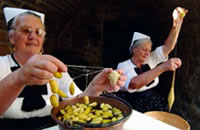Dumping Down and Silk
Each year, the down and silk industries kill thousands of geese and silkworms. Silk producers excuse their actions with claims that worms are "simple" forms of life, but consumers are beginning to question the unnecessary killing of even tiny, sometimes complex, and certainly feeling, creatures like these.
Down on Down
"Down" is the soft underfeathering often plucked out of live geese who are raised for food. In many European countries, geese are allowed to mature during the first eight or nine weeks of life. Reaching adulthood, they are divided by color. Gray geese are caged and force-fed - a funnel is inserted into their throats and a salty, fatty corn mash is forced down it, up to six pounds a day - until they are overweight and their livers have ballooned to four or more times the normal size. Then they are killed for pâté de foie gras. White geese are plucked repeatedly to supply filling for products such as comforters, pillows, and ski parkas.
Plucking the geese causes them considerable pain and distress. Four or five times in their lives, they will squirm as a plucker tears out five ounces of their feathers. A skilled plucker can handle 100 birds a day. After the last plucking, the geese have five weeks to grow more feathers before they are sent through a machine that plucks their longest feathers. From there they go to the slaughterhouse. At least one major U.S. down seller, the Company Store (500 Company Store Rd., La Crosse, WI 54601-4477), buys down from Hungary and other European countries.
In North America, ducks and geese are hunted and raised for their feathers (and for food). People also gather eider down from the nests of female eider ducks, who pluck the down from their breasts to line their nests and cover their eggs. Gathering the soft feathers can kill unhatched ducklings.
Apart from the cruelty involved in its production, down has drawbacks as a cold-weather insulator that synthetic insulators do not have. Not only is down expensive, it also loses its insulating ability when wet, whereas the insulating capabilities of cruelty-free synthetic fillers are retained in all weather.
Sack Silk
Silk is the fiber silkworms weave to make cocoons. To obtain the silk, silk distributors boil the worms alive in their cocoons. Worms are sensate - they produce endorphins, a physical response to pain - and anyone who has seen worms scramble when their dark homes are uncovered recognizes this.
Humane alternatives to silk include nylon, milkweed seed pod fibers, silk-cotton tree and ceiba tree filaments, and rayon.
References:
- "And a Cow Jumped Over the Moon", The Animals' Voice, February 1989, p. 56
- Kamm, Henry, "No Bed of Feathers for a Goose in Hungary", The New York Times, June 2, 1988
- Pearson, Marcia, "Down", The Compassionate Shopper, Winter 1987-88
- Schneider, Al, "Down-Filled Clothing vs. Synthetics", Letters, The Washington Post Health Section, January 16, 1990
![Silk worm [ 45.89 Kb ] Silk worm [ 45.89 Kb ]](/data/image_1_1119.png)


